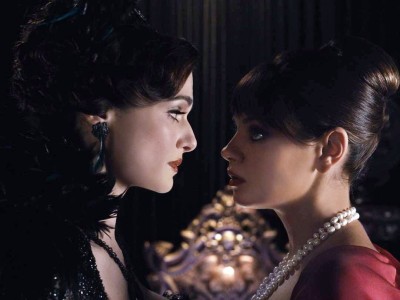“Spring Break for eva, and eva…” – It’s the nonsense chant of a generation of young Americans, who believe that being young and from the Land of the Free they are entitled to their brief weeks of hedonism. Yet we see them in their university classes not paying attention, not caring. Harmony Korine’s dissection of this culture, Spring Breakers, is a clever curiosity, one which strikes with as much satire as it does advertise a lifestyle.
Korine, who wrote 1995’s challenging tale of take-it-all young Americans, Kids, tackles similar concepts here. Four college girls want to go on Spring Break to Florida. They “deserve” it. So when funds are too tight, three of the girls, Candy, Brit and Cotty, rob a local restaurant with a hammer and a toy gun and pool the cash together. Faith, the helpfully monikered Christian of the group, is not as disapproving of their methods as she is excited for the trip, and follows her three less innocent friends to Florida.
In sequences as outlandish as any late ’90s rap music video, we witness the desired atmosphere of Spring Break – bodies and breasts shimmy and shake on the beach, liquids are poured on and drunk off young women. It all looks fun and yet Korine’s assemblage of the footage finds a grotesquery in it. The monstrous faces of Aphex Twin’s ‘Windowlicker’ video are nowhere to be seen, but they’re there, beneath the fresh youthful skin of these deluded partygoers.
Our four heroines fit right in, although a re-enactment by the rebellious three of their illegal escapades does begin to worry Faith, who starts to think it may be time to head for home. Too late; they are soon arrested at a drug-fuelled party, and, broke, are left to rot in jail. Their saviour comes in the form of Alien (James Franco), a drug-dealer, DJ, gangsta poseur of the highest order, who takes the girls in under his wing. He shows them a good time. He shows them what affluence is. He shows them what you can do with real guns.
In typical Korine style Spring Breakers eschews much in the way of narrative in favour of a series of perverse set-pieces. Before the girls go to Florida we see Faith with her Bible group, headed by a pastor played by wrestler Jeff Jarrett, who preaches how awesome God’s forgiving nature is. It feels straight out of Korine’s Julien Donkey-Boy, despite the fact this glossy film could not look any more different to that Dogme venture. Other sequences include the girls getting high at a party where the fractured editing keenly captures drug-induced wildness, Alien listing off all the bling and swag he owns as if on an episode of MTV’s Cribs and, later, a vicious slow-motion robbery and assault accompanied on the score by a sombre Britney Spears song. These are inspired moments in an otherwise one-trick film.
In some ways little more than an update of 1960’s teensploitation morality tale Where the Boys Are, Spring Breakers hits the culture of entitlement hard, but does not do a lot else. The catch is that Korine has cast two former Disney stars, Vanessa Hudgens as Candy and Selena Gomez as Faith, in leading roles, as well as former teen soapstar Ashley Benson as Brit. But after five minutes of the film, once we’ve seen Vanessa Hudgens dragging from a bong, the shock value of the casting is gone. Korine has his young wife, Rachel Korine, playing Cotty, do much of the “heavy lifting”, appearing in the raunchiest scenes that it might have been more shocking to see a High School Musical alumnus perform.
The addition of Franco, enjoying himself intensely in the flamboyant, preposterous role of Alien, helps fuel the condemnation of middle class hero-worship of criminals. Korine pointedly has Alien’s TV at home set up to play Brian De Palma’s Scarface on a loop, a scathing attack on the cult of Tony Montana in American pop culture. What Korine risks is creating a similar cult around the charismatic Alien – sure he’s inviting his targets to worship the fraud, but is this not somehow undermining the criticism?
Still, while the central theme is lacking, and the young starlets do not make much of the material, there remains some excellent filmmaking on display here. The music, mostly by electronic artist Skrillex and Drive composer Cliff Martinez (with a little Britney thrown in), captures the tone throughout. Cinematographer Benoît Debie, best known for shooting Gaspar Noé’s Irreversible, has a remarkable eye for finding the beauty in horror and the horror in beauty, and the slick, sickly gloss of this film’s first half gives away to a neon-lit nighttime of desire and danger. The editing is mostly sharp although there is a tendency to recycle imagery, often patronisingly on cue when characters refer to earlier events or themes.
So who is Korine’s film for? If it’s aimed at the actual Spring Break-going type, then will the satire not fly over their heads? If they don’t walk out, will they enjoy it without irony, wishing they could be Brit or Candy, or worse still, Alien? For the art house crowd who are used to Korine’s repulsive, exploitative but somehow often moving shtick, this is exactly what you might expect, but it is short on ideas and entertainment for long stretches.
Spring Break is over, it’s time for everyone to go back to their lives.
3/5







